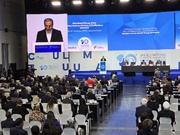Condoms are proven to be 98% effective in preventing STIs and HIV. In addition, male and female condoms prevent unintended pregnancies when used correctly and consistently.
Despite increased use of condoms over the past two decades, studies show that reported use of condoms during a person’s most recent sexual encounter with a non-regular partner ranged from 80% in some countries to less than 30% in others. There is an urgent need for countries to strengthen demand for and supply of condoms and water-based lubricant.
UNAIDS is calling for increased investments by donors and governments for the promotion and distribution of male and female condoms in order to ensure everyone has access to condoms to protect themselves and their partners from HIV, STIs and unintended pregnancies.
“Investing in condoms saves lives,” said UNAIDS Deputy Executive Director Luiz Loures. “It is unacceptable that so many people are becoming infected with HIV and sexually transmitted infections because they do not have access to something as easy to use, effective and low cost as condoms.”
Condoms are extremely cost-effective and have made a major contribution to preventing new HIV infections. An estimated 50 million HIV infections have been averted the rough condom use since the 1980s. Despite the low cost of condoms, international funding for condom procurement in sub-Saharan Africa has slowed in recent years. To achieve UNAIDS’ target of reducing new infections to fewer than 500 000 by 2020, more political commitment and increased investment in HIV prevention are needed.
Collaborative partnerships are needed to support national efforts to encourage the use of condoms. Action is also needed to increase domestic funding and private sector investment in condom distribution and promotion.
UNAIDS is working together with the United Nations Population Fund and other partners to support renewed investment in condom programming and to accelerate the scale-up of their use in the countries where most new STIs are occurring. The new UNAIDS 2016–2021 Strategy has set an ambitious global target to increase the availability of condoms to 20 billion per year by 2020 in low- and middle-income countries and to achieve 90% condom use during the most recent sexual activity with a non-regular partner.
PT/PR




















Your Comment